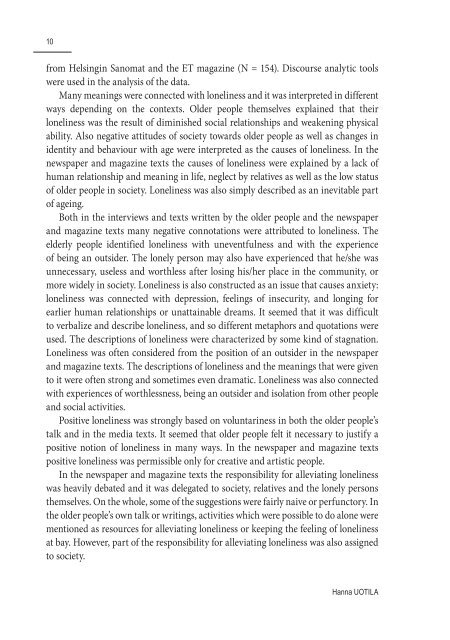Avaa tiedosto - TamPub - Tampereen yliopisto
Avaa tiedosto - TamPub - Tampereen yliopisto
Avaa tiedosto - TamPub - Tampereen yliopisto
You also want an ePaper? Increase the reach of your titles
YUMPU automatically turns print PDFs into web optimized ePapers that Google loves.
10<br />
from Helsingin Sanomat and the ET magazine (N = 154). Discourse analytic tools<br />
were used in the analysis of the data.<br />
Many meanings were connected with loneliness and it was interpreted in different<br />
ways depending on the contexts. Older people themselves explained that their<br />
loneliness was the result of diminished social relationships and weakening physical<br />
ability. Also negative attitudes of society towards older people as well as changes in<br />
identity and behaviour with age were interpreted as the causes of loneliness. In the<br />
newspaper and magazine texts the causes of loneliness were explained by a lack of<br />
human relationship and meaning in life, neglect by relatives as well as the low status<br />
of older people in society. Loneliness was also simply described as an inevitable part<br />
of ageing.<br />
Both in the interviews and texts written by the older people and the newspaper<br />
and magazine texts many negative connotations were attributed to loneliness. The<br />
elderly people identified loneliness with uneventfulness and with the experience<br />
of being an outsider. The lonely person may also have experienced that he/she was<br />
unnecessary, useless and worthless after losing his/her place in the community, or<br />
more widely in society. Loneliness is also constructed as an issue that causes anxiety:<br />
loneliness was connected with depression, feelings of insecurity, and longing for<br />
earlier human relationships or unattainable dreams. It seemed that it was difficult<br />
to verbalize and describe loneliness, and so different metaphors and quotations were<br />
used. The descriptions of loneliness were characterized by some kind of stagnation.<br />
Loneliness was often considered from the position of an outsider in the newspaper<br />
and magazine texts. The descriptions of loneliness and the meanings that were given<br />
to it were often strong and sometimes even dramatic. Loneliness was also connected<br />
with experiences of worthlessness, being an outsider and isolation from other people<br />
and social activities.<br />
Positive loneliness was strongly based on voluntariness in both the older people’s<br />
talk and in the media texts. It seemed that older people felt it necessary to justify a<br />
positive notion of loneliness in many ways. In the newspaper and magazine texts<br />
positive loneliness was permissible only for creative and artistic people.<br />
In the newspaper and magazine texts the responsibility for alleviating loneliness<br />
was heavily debated and it was delegated to society, relatives and the lonely persons<br />
themselves. On the whole, some of the suggestions were fairly naive or perfunctory. In<br />
the older people’s own talk or writings, activities which were possible to do alone were<br />
mentioned as resources for alleviating loneliness or keeping the feeling of loneliness<br />
at bay. However, part of the responsibility for alleviating loneliness was also assigned<br />
to society.<br />
Hanna UOTILA














